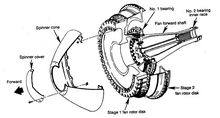| This article needs additional citations for verification. Please help improve this article by adding citations to reliable sources. Unsourced material may be challenged and removed. Find sources: "Fan disk" – news · newspapers · books · scholar · JSTOR (December 2009) (Learn how and when to remove this message) |




A fan disk is the central hub of a fan in a turbofan engine. Fan blades are attached to the fan disk, which is rotated by a shaft driven by a gas turbine. In modern passenger aircraft, most of the propulsive thrust comes from fans, which are driven by gas turbines. A single stage fan was developed to produce high thrust and act as a multi-bladed propeller. Fan disks are attached to a shaft that is driven by a multistage Low Pressure Turbine (LPT) to reduce mechanical stress.
Air enters the front of an engine, where a fan increases the pressure by rotating within a duct. Most of the pressurized air is exhausted through the rear of the engine, where it expands and its velocity increases.
Fan disks are large and heavy. The one shown in the photo is over 31 inches (1.2 m) in diameter, and rotates up to 3800 rotations per minute (RPM). Fan disks must withstand the centrifugal force of the attached fan blades. Because of their size and weight, a failed fan disk can severely damage an aircraft, as happened with United Airlines Flight 232 in 1989. While operating there is increased aerodynamic loading on the fan disk while the fan blade tips are traveling faster than sound. A fan blade weighing 15-lbs can experience upwards of 60 tons of centrifugal force.
Fan disks are usually made of a titanium alloy, which is strong, light weight, and resistant to corrosion.
See also
- United Airlines Flight 232, which crashed after the fan disc in its number two engine shattered and damaged all hydraulic systems
References
- Khurana, K. C. (2009). Aviation management : global perspectives. New Delhi: Global India Publications. p. 60. ISBN 9789380228396.
- Gunston, Bill (2006). The Development of Jet and Turbine Aero Engines. PSL. ISBN 0-7509-4477-3.
- "General Electric CF6-6 Turbofan Engine, Cutaway". Smithsonian Institution. Retrieved 28 October 2018.
- "AAR-90-06, Aircraft Accident Report, United Airlines Flight 232 McDonnell Douglas DC-10 Sioux Gateway Airport, Sioux City, Iowa" (PDF). National Transportation Safety Board. 19 July 1989. Retrieved 28 October 2018.
- Wilson, David (2014). The Design of High-Efficiency Turbomachinery and Gas Turbines. The MIT Press. ISBN 9780262526685.
- Hill, Phillip (1992). Mechanics and Thermodynamics of Propulsion. Addison-Wesley Publishing Company, Inc. ISBN 0201146592.
Muhammad Adnan, Liu Shujiel; FEA Analysis and Fatigue Life Prediction of Aircraft Turbine Disk; North American Academic Research, 4(4) 10-19, Apr 2021, https://doi.org/10.5281/zenodo.4670446
This article about aircraft components is a stub. You can help Misplaced Pages by expanding it. |
- Muhammad Adnan, Liu Shujiel; FEA Analysis and Fatigue Life Prediction of Aircraft Turbine Disk; North American Academic Research, 4(4) 10-19, Apr 2021, https://doi.org/10.5281/zenodo.4670446